Tier 12 (continued)
121. Taylor Ward (OF, LAA) – The decision-making went from average to incredible in 2023, and Ward showcased a strong ability to make contact with flashes of above-average power. Injuries and inconsistency foiled him for a second consecutive season, but like Vaughn, I’m willing to get back on the saddle one more time to see if we can get a .275 average with 25 home runs along with 160 combined runs and RBI. I think the ceiling is as good or better than Vaughn’s, but I also admit that the floor is lower.
122. Jorge Polanco (2B/3B, SEA) – Polanco kept the double-digit walk rate from 2023 (though it came with an elevated strikeout rate) and also slugged an impressive 14 home runs in just 80 games, but it was a second straight season where injuries kept him out for a large chunk of the season. Polanco has 25 home run upside with decent ratios and counting stats as the presumed cleanup hitter in Seattle, but the biggest question mark is whether he can stay healthy enough to make an impact.
123. Ryan Mountcastle (1B, BAL) – Injuries shortened his 2023 season, but Mountcastle did show good signs when he was active. His 18 home runs over 115 games would equate to about 25 over a full season, and the improved lineup around him provided a boost to his counting stats compared to 2022. There’s a chance that the Orioles push Mountcastle to the bottom third of the lineup or platoon him when he’s slumping due to his inability to effectively field any position and the fact he’s a righty, which caps his ceiling quite a bit, but the 23-25 home run upside with 75-80 RBI and a .270 average is worth chasing as a late corner infielder in standard formats.
124. Steven Kwan (OF, CLE) – Few players can boast the bat-to-ball skills that Kwan has, but he’s struggled to make a big fantasy impact with that hit tool. Kwan has just 11 home runs across two full seasons, and this number is unlikely to improve based on what we’ve seen.
The skills are there to give Kwan a ceiling that includes a .300 average, 100 runs scored, and 30 stolen bases, but when you have the lowest hard-hit rate and the third-worst barrel rate in baseball, your path to fantasy relevance requires a lot of things to go your way. Kwan finished 2023 outside the top-100 hitters, and if the Guardians’ offense flounders again or if Kwan continues to be capped at 20 steals by his manager, or if he has rough batted ball luck, or if he loses his hold on the leadoff spot, it could happen again. In points leagues or deep formats that value the high number of plate appearances, Kwan should be moved up multiple tiers.
125. Keibert Ruiz (C, WAS) – 2023 was a breakout for Ruiz, and due to his strong hit tool, it could very well be the expectation going forward. The 18 home runs are probably close to the top of what I’d project for him, but the .260 batting average has room to improve thanks to Ruiz possessing one of the best contact abilities in the league that persists across all pitch types. The power is the primary thing to be suspicious of, as he doesn’t make very much hard contact nor does he barrel the ball very often, but Ruiz’s ability to put the ball in play consistently creates a very high floor that should keep him as a set-and-forget catcher in virtually all formats. In points leagues, you can even lift him a tier as he rarely strikes out and should continue to play a lot of games in Washington.
126. Brandon Drury (1B/2B, LAA) – So much for a power regression, eh? Drury only played in 125 games in 2023, but still managed to hit 26 home runs for the Angels as a follow-up to the 28 he hit back in 2022. I’m inclined to believe that the Drury we saw in 2022 and 2023 is the one we will get in 2024, and that means a .260 batting average, 25-27 home runs, and 150 combined runs and RBI over a full season.
Of course, Drury isn’t known for playing full seasons as he’s never played in 140 games in a season since going pro in 2010. He missed significant time in 2018, 2019, 2020, and 2021, so projecting more than 120 games is a big risk to take. That said, in shallow leagues, he remains an excellent back-end infielder who can provide power and RBI while batting in the heart of the order for a bad team.
127. Carlos Correa (SS, MIN) – Believe it or not, this was the fourth consecutive season that Correa appeared in over 80% of his team’s games, though unlike the two previous campaigns, it was not considered a success. Correa fell flat in almost every category, and one explanation could be the plantar fasciitis he battled throughout the season. Assuming Correa finds a way to manage the condition over the offseason (it doesn’t require surgery), he could certainly recapture his 2021 or 2022 form and put up 22-25 home runs with solid counting stats and a .280 or better batting average. The floor is particularly low for the former first-overall pick, but there’s enough ceiling here that someone should probably draft him in your league.
128. Jack Suwinski (OF, PIT) – Suwinski has issues with zone contact (which you may have noticed is a red flag for me), but a combination of power, speed, and playing time still led to 26 home runs and 13 steals for the 25-year-old southpaw. Suwinski is much better suited to OBP leagues where his high walk rate can make his ratios more than acceptable, but in standard leagues, you shouldn’t expect more than a .220 average with subpar counting stats as part of a dismal Pirates lineup.
129. Francisco Alvarez (C, NYM) – Alvarez has the upside to be, well, Cal Raleigh but with a better batting average, but unlike Raleigh, he doesn’t currently have the luxury of being the DH when he’s not catching. If Alvarez can find some consistency in 2023, we could see him get those DH plate appearances, but until then, he’s an upside power-hitting catcher.
130. Esteury Ruiz (OF, OAK) – NFBC players will take Ruiz a lot earlier than this due to the fact he’s almost certain to lead the AL in stolen bases after swiping 67 bags in 2023, but keep in mind that Ruiz fell short of 50 runs scored and 50 RBI and that the .254 batting average and .309 OBP are just about as good as it’s going to get due to his aggressive approach and complete lack of power. He will steal a boatload of bases and not hurt your ratios that much, which is not super valuable in head-to-head categories formats, but those in roto leagues will probably have him in a tier or two above this.
131. Daulton Varsho (OF, TOR) – It was a disappointing first season in Toronto as he fell short of expectations in almost every category. A big part of the explanation is the 19% pop-up rate, the second-worst mark in the league and almost double the rate he posted in 2022. Our PLV metrics indicate he was incredibly aggressive against fastballs to start the season, though it improved as the season went on which is also reflected in his decision value against those fastballs (though it’s worth noting that his pop-up rate was worse at the end of the season, so decision-making against fastballs didn’t cause that specific problem).
Varsho should be a 20-20 outfielder in Toronto and his counting stats should improve naturally by rebounds from Guerrero Jr. and Bichette, though the batting average will stay in the basement unless he makes better decisions against fastballs and/or cuts down on the pop-ups.
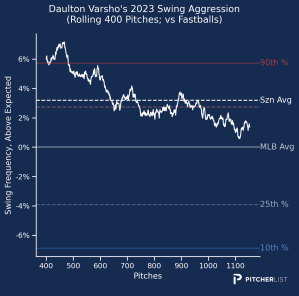
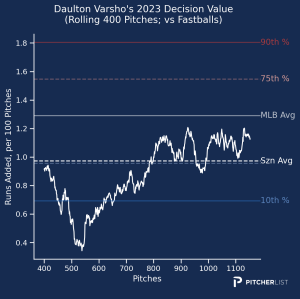
Tier 13
132. Starling Marte (OF, NYM) – Injuries loom large for Marte as he enters his age-35 season but in just 86 games he managed to steal 24 bases in the new environment for the Mets. I’d advise against projecting Marte for more than 110-120 games, but the upside even in that short time could be 10-15 home runs and over 30 steals. That kind of upside is hard to come by at this stage, and in shallow leagues, it makes Marte worth scooping up near the end of the draft.
133. Logan O’Hoppe (C, LAA) – O’Hoppe should be the primary catcher for the Angels, though injuries took him out for most of 2023. While he was healthy, though, O’Hoppe clobbered 14 home runs in just 51 games and while that pace isn’t sustainable, 110 games could give way to 22-25 home runs with a .250 average, and in 130 games (which is all the rage among catchers these days), there’s an outside chance at 30.
134. Jonathan India (2B, CIN) – At the time of writing, Jonathan India still projects to be an everyday player for the Reds between second base and DH (with most of his time spent doing the latter), and in that role, there’s plenty of upside for India to hit over 20 home runs while stealing 15 or more bases. India has fallen short of 120 games for two straight seasons after his breakout rookie year, and the missed time has turned into waves of inconsistency. Heading into his age-27 season, India has an opportunity to once again be a part of the future of the Reds, but there’s considerable injury risk as well as an uncertain role that makes him a challenging player to rely on as we head into 2024.
135. Josh Bell (1B, MIA) – It may not always be pretty, but Bell once again found a way to drive in more than 70 runners and hit more than 20 home runs between his time with the Guardians and Marlins, with his best stretches coming with the latter. Bell will once again be a Marlin, and if he can recreate the 37.2% fly ball rate (which is about as high as it gets for Bell), we should see another 20+ home run season with improved counting stats. There’s also a chance he goes back to hitting grounders and becomes waiver material, but the 23-25 home run, 80 RBI upside with good ratios is worth gambling on as a late corner infielder.
136. Jordan Lawlar (SS, ARI) – Lawlar third on this list over Holliday? Matt Heckman has been one of the biggest advocates for Lawlar and 14 major league games will not change his mind. Lawlar’s home run per fly ball numbers have been impressive throughout his professional career and there is 40+ stolen base potential here. He should usurp Geraldo Perdomo as the everyday shortstop early on in 2024 (possibly as early as Opening Day) and be a reliable fantasy asset for managers this season.
Here is what Matt concluded about Lawlar in the composite article:
“The speed and power combination possessed by Lawlar is exciting. The upside in his profile is huge and there is no reason to overreact to a small major league sample size. He will have a fantasy impact in 2024 and should be on your radars during draft season.”
137. Alex Verdugo (OF, NYY) – Verdugo was exceptionally average last season as he saw his batting average fall to a middling .264 after five straight seasons hitting at least .280, but a move to the Bronx and a presumably better lineup should hopefully squeeze more juice out of the contact-oriented outfielder. Additionally, if LeMahieu struggles at all in the leadoff spot, Verdugo would probably be the next man up to take that role in front of Judge and Soto, and it wouldn’t be hard to imagine Verdugo piling up a ton of runs scored in that role.
138. Gabriel Moreno (C, ARI) – Moreno found his stride in the second half last season, hitting .313/.383/.511. This improved line correlates to improvements in both his contact ability and his decision-making, which align with the skills we saw in him as a prospect.
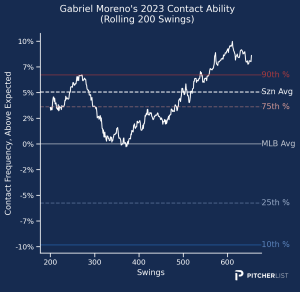
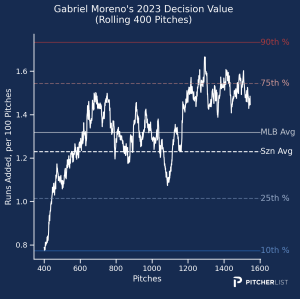
Moreno is unlikely to hit 15 home runs in a season, but his batting average should be north of .280 and the counting stats will be quite good for a catcher (think 120-130 combined runs and RBI). Moreno also has some sneaky speed and should chip in six to eight steals too, if you’re into that sort of thing.
139. Jackson Holliday (SS, BAL) – Holliday’s quick ascent through the minor leagues has been impressive. With the potential to be a generational talent, Holliday is on the cusp of making his major league debut. With a strong spring, he could find himself as the team’s Opening Day shortstop. There is also a chance the team opts to give Holliday some more time to develop in Triple-A considering he does not turn 21 until next December. There is five-category potential in Holiday’s bat although we have yet to see his raw power fully translate to game power.
Here is what Martin concluded in our composite write-up:
“The Orioles are so loaded with young talent and Holliday is the cream of the crop. The team has already stated Holliday will compete in spring training to make the Opening Day roster. Personally, I think it is a foregone conclusion that Holliday will not only make the Opening Day roster, but he’s a heavy favorite for AL Rookie of the Year.”
140. Justin Turner (1B/2B/3B, TOR) – It was a great season on all accounts for the now-39-year-old Turner and he heads to the Blue Jays after setting career highs in runs scored and RBI. It’s hard to imagine there’s a lot of tread left on these tires, but Turner should get as much run as his body can handle in Toronto.
Tier 14
141. Byron Buxton (UT, MIN) – 2017 stands alone as the sole season where Buxton played at least 100 major league games as he found his way into just 85 of them in 2023 before hitting the IL. The Twins still expect him to be their starting centerfielder, and we saw enough to still project Buxton for 30 home runs if he somehow plays in 140 games and could also steal 15 bases. We also saw enough to know that Buxton’s ratios are probably going to stay low due to his extreme flyball tendencies, but if you want to pick up a lottery ticket, Buxton still fits the bill.
142. Colt Keith (3B, DET) – Keith became the second prospect this off-season to receive a multi-year contract prior to making his major league debut. The contract all but assures us that Keith will open as the Tigers’ everyday second baseman. Keith’s profile should translate well to the major leagues as he combines plus power with strong plate discipline to form a solid all-around approach. He is not going to be very useful in the stolen base category, but he figures to be a reliable four-category contributor batting in the middle of Detroit’s lineup.
Here is what Steve concluded from our composite article:
“Keith has risen to a top prospect in baseball since being drafted and has done it with his ability to hit the baseball. Keith should get a chance to play every day at the hot corner in Detroit starting on opening day in 2024.”
143. Tyler O’Neill (OF, BOS) – Another year, another rash of injuries and poor performance from O’Neill despite possessing plus power and speed. O’Neill enters 2024 as hyped as he’s ever been now that he’s been traded to a Red Sox team that doesn’t have any significant threat to his playing time (other than O’Neill’s own body). Fenway could be a boon to O’Neill’s power numbers as it provides an even greater incentive to pull the ball. Additionally, the chart below shows growth in his decision-making that could help him keep that double-digit walk rate and lowered strikeout rate in 2024. The extreme injury risk and erratic performance in the last few seasons make it hard to rank him higher, but if you want potential, there’s evidence there to support its existence.
As a caveat, those in deeper formats who can’t easily replace an outfielder should move O’Neill down your list by at least one or two tiers, if not more. This ranking only works in standard 12-teamers because whiffing on an outfielder at this stage of the draft doesn’t do any long-term damage.
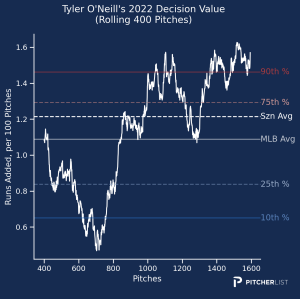
144. Matt Chapman (3B, FA) – Chapman’s hard-hit rate in 2023 was the best of his career (by a pretty wide margin) despite putting up 10 fewer home runs than he had in each of the last two seasons. Part of the issue may have been luck, as Chapman’s 39 doubles were 12 more than he hit in 2022 and 24 more than he had in 2021, and he also didn’t pull the ball as much as he did in 2022. 25-30 home runs are possible for Chapman no matter where his free agency takes him, but his strikeouts, streakiness, and low batting average will frustrate even the most patient fantasy managers.
145. Jonah Heim (C, TEX) – Heim was not the same hitter after hitting the IL in late July, hitting just .202/.268/.333 in 41 regular season games. That injury and following slump allowed Garver to steal Heim’s spot in the lineup, and as it stands now, it’s hard to see Heim climbing back to the top two-thirds of the order. 20 home runs is a reasonable expectation due to the volume we should expect for Heim in 2024, but the ratios, which historically were putrid, are hard to project. If he finds his first-half form, this is a top-five catcher, but the .214/.275/.374 line from his pre-2023 career would make Heim a very difficult catcher to roster for a full season.
146. Matt Wallner (OF, MIN) – Wallner has a difficult path to a full-time role due to the nature of the Twins roster and his weakness to left-handed pitching, but there’s no doubting his raw power after he hit 14 home runs in 76 games. Keep Wallner in the back of your mind, especially in OBP formats, when you need power at the end of a deep draft or during the season when perusing the wire, but even if Wallner is healthy for all of 2024, it’s unlikely he gets to 120 games played while in a strict platoon.
147. Jeff McNeil (2B/OF, NYM) – McNeil is essentially Arraez-lite. He puts a ton of balls in play, rarely strikes out, and scores runs. He doesn’t do those things quite as well as Arraez, but McNeil does them consistently. McNeil is slightly more likely to get to double-digit home runs and steals, but 10 is pretty close to the cap for him in both categories.
148. Vaughn Grissom (SS, BOS) – If you’re looking for a high-floor, low-ceiling middle infielder who should get to 12-15 home runs and stolen bases with a decent batting average and low counting stats, Grissom is your guy! You don’t often see a player with just 64 games major league games with such tight projections, but Grissom’s high-contact, low-to-medium power approach near the bottom of a not-so-great lineup provides an uncomplicated projection based on players we’ve seen before who are like him. For Grissom to break into the top 100 hitters, we’d need to see him keep the ground ball rate at or below 45% (something he did in the minors) and that line drive rate would need to be above 20% (another thing he did in the minors). That combination was the secret to his success in Triple-A, where he hit 36 doubles with a .330 batting average. You can bump Grissom up a tier or so in most points leagues due to his contact-oriented approach.
149. Tommy Edman (2B/SS/OF, STL) – I was not at all in on Tommy Edman in 2023 due to his move to the bottom of the order and his historical performance in that spot, and while Edman has a clear starting role and is coming off a third straight season with at least 27 home runs, I’m still not overly excited about the other assets Edman brings to the table. Edman finished as the 130th best hitter last season according to the FanGraphs auction calculator with stolen bases being the only category where he didn’t provide negative value. I don’t see much reason to suspect anything to improve much in 2023, which makes Edman better suited to deeper roto leagues than anything else for the speed.
Tier 15
150. Jake Cronenworth (1B/2B, SDP) – Cronenworth could find his way back to the heart of the order with Soto now in New York, and hitting between some combination of Bogaerts, Machado, and Tatis is a good way to drive in 80 runners and score 80 runs. The batting average will likely be .240 or worse and he’s not likely to exceed 15 home runs, but Cronenworth should play enough to accumulate counting stats and be a high-floor, low-ceiling option for those in deeper formats.
